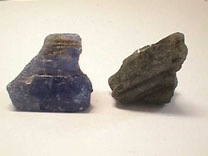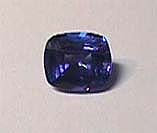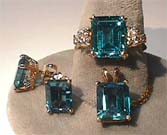 |
 Heat Treatment of Gemstones Heat Treatment of Gemstones |
Rough tanzanite after (left), and before,
heating to bring out blue color
Consumer Information What is the story behind this treatment?: Heating of gemstones to enhance their color goes back centuries. It is considered a natural type of treatment since the process is basically a continuation of the processes that occur in the ground. The stone is heated to a very high temperature, which causes the inclusions to reform themselves and improve the color by making either darker, lighter, more intense, or of a different color. It has been properly stated that without heat treatment the world would be without many colored gemstones. Because colored gemstones occurring in the colors we see are very rare. But heating can take an off-color stone and turn it into a beautiful gemstone. So don't be worried about heat treatment.
What does this treatment do to the stone?: Basically, it rearranges the atoms in the gemstone. Sometimes, as in the case of ruby, the stone is heated almost to a point of melting, which lets the aluminum oxide in the stone reform to what is basically a new crystal structure. This lets the chromium reform to give off a better color of red. The same can apply to a type of sapphire known as gouda sapphires. These are milky white sapphires that turn blue, and account for many of the promotional quality sapphires out on the market today. Does this treatment save money?: Oh Yeah! For instance, a 3.00 carat fine blue sapphire of natural, unheated color can sell for as much as US$20,000.00, while a heated stone of the same color can go for as little as $1500.00. Which means that you will always want to have a proper gemological evaluation for any sapphires, ruby, etc...that you buy. What do I need to know before going shopping?: Always stay with a professional, independent jeweller with some serious gemological training. There can be a HUGE price difference in two gemstones that appear the same color and clarity due to heat treatment. And it takes someone with some good experience and good gemological knowledge to be able to identify one from the other. So stay with someone with a good reputation for quality, and someone who handles enough gemstones to be able to have some good connections with colored gemstone suppliers. Note: Stay away from the discount stores like Service Merchandise, Sams, Walmart, etc...when shopping for fine quality colored gemstones. And for that matter...stay away from most of the Internet sellers. Colored gemstone shopping is "business for the eyes" as a good friend from Israel once told me. You can't buy a quality gemstone from someone claiming discounts, and you can't buy a quality gemstone based on a picture on your computer screen. Stay with a local professional jeweller. Fine quality colored gemstones are never discounted because they are too rare. And buying a colored gemstone without seeing what it looks like to your own eyes is buy what we in Texas call a "pig in a poke." If you can't see it, you won't know what you got until you get home with it. And then its too late.
Blue topaz before heat treatment, and after heat treatment set in jewelry. Special Identifying Properties
and Tests: There are a
number of ways to identify heat treatment in sapphires. One is
the easy way to find the halo effect around included crystals.
This is where the inclusions caused fracturing of the stone when
the heat was applied. Also (which is now taught to you GIA Graduate
Gemologist...unfortunately) heated blue sapphires will generally
lose their iron spectrum lines in the 4400 to 4500 region. Natural
blue sapphires will generally have nice absorption lines in this
region to due iron content. This is not diagnostic but I can tell
you that I have not seen the absorption bands in heated sapphires.
And the absence of these lines will also serve as a signpost that
you might have a synthetic. But a nice strong line in the 4500
will be a strong case for a natural blue that is not treated by
heat. Beyond that, check with a good reference book like GEMS
by Webster, or Photoatlas if Inclusions in Gemstones by Gubelin.
|
| © 2014 YourGemologist.com and Robert James FGA, GG. All Rights Reserved. Free download for personal study and reference. No part of this website may be copied, duplicated, distributed or posted to another website without the expressed written consent of the copyright holder. |
 Can
I wear it everyday?: Heat
treatment, for the most part, is permanent. As in the case of
the tanzanite shown above. This stone is a brown color coming
out of the ground. But turns a beautiful blue/purple (shown at
left) after heating. The few exceptions would be kunzite which will tend to fade from its medium pink color to light pink
and then colorless in daylight (which is why its called the midnight
stone), and yellow sapphire, which can also fade when
exposed to direct sunlight.
Can
I wear it everyday?: Heat
treatment, for the most part, is permanent. As in the case of
the tanzanite shown above. This stone is a brown color coming
out of the ground. But turns a beautiful blue/purple (shown at
left) after heating. The few exceptions would be kunzite which will tend to fade from its medium pink color to light pink
and then colorless in daylight (which is why its called the midnight
stone), and yellow sapphire, which can also fade when
exposed to direct sunlight.
 Gemological Information
Gemological Information